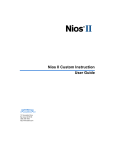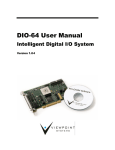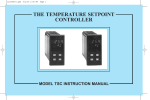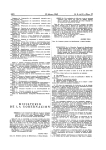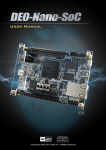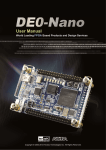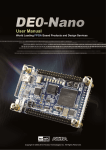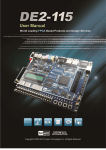Download Nios II Custom Instruction User Guide
Transcript
Nios II Custom Instruction
User Guide
Preliminary Information
101 Innovation Drive
San Jose, CA 95134
(408) 544-7000
http://www.altera.com
Copyright © 2008 Altera Corporation. All rights reserved. Altera, The Programmable Solutions Company, the stylized Altera logo, specific device designations, and all other words and logos that are identified as trademarks and/or service marks are, unless noted otherwise, the trademarks and
service marks of Altera Corporation in the U.S. and other countries. All other product or service names are the property of their respective holders. Altera products are protected under numerous U.S. and foreign patents and pending applications, maskwork rights, and copyrights. Altera warrants
performance of its semiconductor products to current specifications in accordance with Altera's standard warranty, but reserves the right to make
changes to any products and services at any time without notice. Altera assumes no responsibility or liability arising out of the application or use of any information, product, or service described herein except as expressly agreed to in writing by Altera
Corporation. Altera customers are advised to obtain the latest version of device specifications before relying on any published information and before placing orders for products or services.
Printed on recycled paper
ii
UG-N2CSTNST-1.5
Altera Corporation
Contents
Chapter 1. Nios II Custom Instruction Overview
Introduction ............................................................................................................................................ 1–1
Custom Instruction Overview ............................................................................................................. 1–2
Implementing Custom Instruction Hardware ............................................................................. 1–3
Implementing Custom Instruction Software ............................................................................... 1–4
Custom Instruction Types .................................................................................................................... 1–4
Combinational Custom Instruction ............................................................................................... 1–5
Combinational Port Operation .................................................................................................. 1–6
Multi-Cycle Custom Instruction .................................................................................................... 1–7
Multi-Cycle Port Operation ....................................................................................................... 1–8
Extended Custom Instruction ......................................................................................................... 1–9
Extended Custom Instruction Port Operation ..................................................................... 1–11
Internal Register File Custom Instruction .................................................................................. 1–11
Internal Register File Custom Instruction Port Operation ................................................. 1–13
External Interface Custom Instruction ........................................................................................ 1–13
Chapter 2. Software Interface
Introduction ............................................................................................................................................ 2–1
Custom Instruction Examples .............................................................................................................. 2–1
Built-In Functions and User-Defined Macros .................................................................................... 2–2
Custom Instruction Assembly Software Interface ............................................................................ 2–4
Chapter 3. Implementing a Nios II Custom Instruction
Introduction ............................................................................................................................................
Design Example: Cyclic Redundancy Checksum (CRC) .................................................................
Implementing Custom Instruction Hardware in SOPC Builder ....................................................
Open the Component Editor ..........................................................................................................
Add the Synthesis HDL File ...........................................................................................................
Add Simulation Files .......................................................................................................................
Configure the Custom Instruction Signal Type ...........................................................................
Set Up Custom Instruction Interfaces ...........................................................................................
Set the Component Wizard Details ...............................................................................................
Save and Add the Custom Instruction ..........................................................................................
Generate the SOPC Builder System and Compile in the Quartus II Software ........................
Accessing the Custom Instruction from Software ............................................................................
Viewing Results on Nios II Console ..............................................................................................
User-defined Custom Instruction Macro ...........................................................................................
3–1
3–1
3–1
3–2
3–2
3–3
3–3
3–4
3–5
3–5
3–6
3–6
3–7
3–9
Appendix A. Custom Instruction Templates
Overview ................................................................................................................................................ A–1
Altera Corporation
1
Nios II Custom Instruction User Guide
Nios II Custom Instruction User Guide
VHDL Template .................................................................................................................................... A–1
Verilog HDL Template ........................................................................................................................ A–2
Appendix B. Custom Instruction Built-In Functions
Overview ...............................................................................................................................................
Built-In Functions Returning void .....................................................................................................
Built-in Functions Returning int .........................................................................................................
Built-in Functions Returning float .....................................................................................................
Built-in Functions Returning a Pointer ..............................................................................................
B–1
B–1
B–1
B–2
B–2
Appendix C. Porting First- Generation Nios Custom Instructions to Nios II Systems
Overview ................................................................................................................................................ C–1
Hardware Porting Considerations ..................................................................................................... C–1
Software Porting Considerations ....................................................................................................... C–1
Appendix D. Floating Point Custom Instructions
Overview ................................................................................................................................................ D–1
Adding Floating Point Custom Instructions .................................................................................... D–1
Additional Information
Revision History ............................................................................................................................... Info–i
How to Contact Altera ..................................................................................................................... Info–i
Typographic Conventions .............................................................................................................. Info–ii
2
Nios II Custom Instruction User Guide
Altera Corporation
1. Nios II Custom Instruction
Overview
Introduction
With the Altera Nios II embedded processor, you as the system designer
can accelerate time-critical software algorithms by adding custom
instructions to the Nios II processor instruction set. Using custom
instructions, you can reduce a complex sequence of standard instructions
to a single instruction implemented in hardware. You can use this feature
for a variety of applications, for example, to optimize software inner
loops for digital signal processing (DSP), packet header processing, and
computation-intensive applications. The Nios II configuration wizard,
part of the Quartus® II software’s SOPC Builder, provides a graphical
user interface (GUI) used to add up to 256 custom instructions to the
Nios II processor.
The custom instruction logic connects directly to the Nios II arithmetic
logic unit (ALU) as shown in Figure 1–1.
Figure 1–1. Custom Instruction Logic Connects to the Nios II ALU
Nios II Embedded Processor
Custom
Logic
A
Nios II
ALU
+
<<
>>
Result
&
B
Altera Corporation
May 2008
8.0 Nios II Processor 8.0
1–1
Custom Instruction Overview
This chapter contains the following sections:
■
■
“Custom Instruction Overview” on page 1–2.
“Custom Instruction Types” on page 1–4.
For information regarding the custom instruction software interface,
refer to Chapter 2, Software Interface. Forstep-by-step instructions for
implementing a custom instruction, see Chapter 3, Implementing a
Nios II Custom Instruction.
Custom
Instruction
Overview
Nios II custom instructions are custom logic blocks adjacent to the ALU
in the processor’s data path. Custom instructions give you the ability to
tailor the Nios II processor core to meet the needs of a particular
application. You have the ability to accelerate time critical software
algorithms by converting them to custom hardware logic blocks. Because
it is easy to alter the design of the FPGA-based Nios II processor, custom
instructions provide an easy way to experiment with hardware/software
tradeoffs at any point in the design process.
1–2
Nios II Custom Instruction User Guide
Nios II Processor 8.0
Altera Corporation
May 2008
Nios II Custom Instruction Overview
Implementing Custom Instruction Hardware
Figure 1–2 is a hardware block diagram of a Nios II custom instruction.
Figure 1–2. Hardware Block Diagram of a Nios II Custom Instruction
Conduit interface to external
memory, FIFO, or other logic
Custom
Logic
dataa[31..0]
datab[31..0]
Combinational
Combinatorial
result [31..0]
clk
clk_en
reset
Multi-cycle
done
start
n[7..0]
Extended
a[4..0]
readra
b[4..0]
readrb
Internal
Register File
c[4..0]
writerc
The basic operation of Nios II custom instruction logic is to receive input
on the dataa and/or datab port, and drive out the result on its result
port. The custom instruction logic provides a result based on the inputs
provided by the Nios II processor.
The Nios II processor supports different types of custom instructions.
Figure 1–2 lists the additional ports that accommodate different custom
instruction types. Only the ports used for the specific custom instruction
implementation are required.
Figure 1–2 also shows a conduit interface to external logic. The interface
to external logic allows you to include a custom interface to system
resources outside of the Nios II processor data path.
Altera Corporation
May 2008
Nios II Processor 8.0
1–3
Nios II Custom Instruction User Guide
Custom Instruction Types
Implementing Custom Instruction Software
The Nios II custom instruction software interface is simple and abstracts
the details of the custom instruction from the software developer. For
each custom instruction, the Nios II integrated development
environment (IDE) generates a macro in the system header file,
system.h. You can use the macro directly in your C or C++ application
code, and you do not need to program assembly to access custom
instructions. Software can also invoke custom instructions in Nios II
processor assembly language.
f
Custom
Instruction
Types
For more information on custom instruction software interface, refer to
Chapter 2, Software Interface.
There are different types of custom instruction available to suit the
requirements of the application. The chosen type determines what the
hardware interface looks like.
Table 1–1 shows custom instruction types, application, and the associated
hardware ports.
Table 1–1. Custom Instruction Types, Application and Hardware Ports
Type
Combinational
Application
Single clock cycle custom logic
blocks
Hardware Ports
●
●
●
Multi-cycle
Multi clock cycle custom logic block
of fixed or variable durations
●
●
●
●
●
●
●
●
Extended
Custom logic blocks that are
capable of performing multiple
operations
●
●
●
●
●
●
●
●
●
1–4
Nios II Custom Instruction User Guide
Nios II Processor 8.0
dataa[31..0]
datab[31..0]
result[31..0]
dataa[31..0]
datab[31..0]
result[31..0]
clk
clk_en(1)
start
reset
done
dataa[31..0]
datab[31..0]
result[31..0]
clk
clk_en(1)
start
reset
done
n[7..0]
Altera Corporation
May 2008
Nios II Custom Instruction Overview
Table 1–1. Custom Instruction Types, Application and Hardware Ports
Type
Application
Internal Register File
Custom logic blocks that access
internal register files for input and/or
output
Hardware Ports
dataa[31..0]
datab[31..0]
result[31..0]
clk
clk_en
start
reset
done
n[7..0]
a[4..0]
readra
b[4..0]
readrb
c[4..0]
writerc
●
●
●
●
●
●
●
●
●
●
●
●
●
●
●
External Interface
Custom logic blocks that interface to Standard custom instruction ports, plus userdefined interface to external logic.
logic outside of the Nios II
processor’s data path
Note for Table 1–1:
(1)
The clk_en must be connected to the clk_en of all registers in custom instruction in case the Nios II processor
needs to stall the custom instruction during execution.
This section discusses the basic functionality and hardware interface of
each custom instruction type listed in Table 1–1.
Combinational Custom Instruction
Combinational custom instruction consists of a logic block that is able to
complete in a single clock cycle.
Figure 1–3 shows a block diagram of a combinational custom instruction.
Figure 1–3. Combinational Custom Instruction Block Diagram
dataa[31..0]
Combinational
result[31..0]
datab[31..0]
Altera Corporation
May 2008
Nios II Processor 8.0
1–5
Nios II Custom Instruction User Guide
Custom Instruction Types
The Figure 1–3 combinational custom instruction diagram uses the
dataa and datab ports as inputs and drives the results on the result
port. Because the logic is able to complete in a single clock cycle, control
ports are not needed.
Table 1–2 lists the combinational custom instruction ports.
Table 1–2. Combinational Custom Instruction Ports
Port Name
Direction
Required
Application
dataa[31..0]
Input
No
Input operand to custom
instruction
datab[31..0]
Input
No
Input operand to custom
instruction
result[31..0]
Output
Yes
Result from custom
instruction
The only required port for combinational custom instructions is the
result port. The dataa and datab ports are optional. Include them
only if the custom instruction functionality requires input operands. If the
custom instruction requires only a single input port, use dataa.
Combinational Port Operation
This section describes the combinational custom instruction hardware
port operation. Figure 1–4 shows the combinational custom instruction
hardware port timing diagram.
In Figure 1–4, the processor presents the input data on the dataa and
datab ports on the rising edge of the processor clock. The processor
reads the result port on the rising edge of the following processor clock.
The Nios II processor issues a combinational custom instruction
speculatively; that is, it optimizes execution by issuing the instruction
before knowing whether it is necessary, and ignores the result if it is not
required. Therefore, a combinational custom instruction must not have
have side effects. In particular, a combinational custom instruction
cannot have an external interface.
You can further optimize combinational custom instructions by
implementing the extended custom instruction. Refer to “Extended
Custom Instruction” on page 1–9.
1–6
Nios II Custom Instruction User Guide
Nios II Processor 8.0
Altera Corporation
May 2008
Nios II Custom Instruction Overview
Figure 1–4. Combinational Custom Instruction Port Timing Diagram
T0
T1
T2
T3
T4
clk
dataa[ ]
dataa[ ] valid
datab[ ]
datab[ ] valid
result[ ]
result valid
Multi-Cycle Custom Instruction
Multi-cycle or sequential, custom instructions consist of a logic block that
requires two or more clock cycles to complete an operation. Additional
control ports are required for multi-cycle custom instructions. See
Table 1–3.
Figure 1–5 shows the multi-cycle custom instruction block diagram.
Figure 1–5. Multi-Cycle Custom Instruction Block Diagram
dataa[31..0]
datab[31..0]
clk
clk_en
reset
start
Altera Corporation
May 2008
Nios II Processor 8.0
result[31..0]
Multi-cycle
done
1–7
Nios II Custom Instruction User Guide
Custom Instruction Types
Multi-cycle custom instructions can complete in either a fixed or variable
number of clock cycles.
■
■
Fixed length: You specify the required number of clock cycles during
system generation
Variable length: The start and done ports are used in a
handshaking scheme to determine when the custom instruction
execution is complete.
Table 1–3 lists multi-cycle custom instruction ports.
Table 1–3. Multi-Cycle Custom Instruction Ports
Port Name
Direction
Required
clk
Input
Yes
System clock
Application
clk_en
Input
Yes
Clock enable
reset
Input
Yes
Synchronous reset
start
Input
No
Commands custom instruction logic to start execution
done
Output
No
Custom instruction logic indicates to the processor that
execution is complete.
dataa[31..0]
Input
No
Input operand to custom instruction
datab[31..0]
Input
No
Input operand to custom instruction
result[31..0]
Output
No
Result from custom instruction
As indicated in Table 1–3, the clk, clk_en, and reset ports are
required for multi-cycle custom instructions. However, the start, done,
dataa, datab, and result ports are optional. Implement them only if
the custom instruction functionality specifically needs them.
Multi-Cycle Port Operation
The section provides operational details for the multi-cycle custom
instruction hardware port. Figure 1–6 shows the multi-cycle custom
instruction timing diagram.
■
■
The processor asserts the active high start port on the first clock
cycle of the custom instruction execution. At this time, the dataa
and datab ports have valid values and remain valid throughout the
duration of the custom instruction execution. The start signal is
asserted for a single clock cycle.
Fixed or variable length custom instruction port operation:
●
Fixed length: Once the custom instruction is started, the
processor waits a specified number of clock cycles, and then
reads result. For an n-cycle operation, the custom logic block
1–8
Nios II Custom Instruction User Guide
Nios II Processor 8.0
Altera Corporation
May 2008
Nios II Custom Instruction Overview
■
■
■
must present valid data on the nth rising edge after the custom
instruction is executed.
●
Variable length: The processor waits until the active high done
port is asserted. The processor reads the result port on the
clock edge that done is asserted. The custom logic block must
present data on the result port on the same clock cycle that the
done port is asserted.
The Nios II system clock feeds the custom logic block’s clk port, and
the Nios II system’s master reset feeds the active high reset port.
The reset port is asserted only when the whole Nios II system is
reset.
The custom logic block must treat the active high clk_en port as a
conventional clock qualifier signal, ignoring clk while clk_en is
deasserted.
You can further optimize multi-cycle custom instructions by
implementing the extended internal register file, or by creating
external interface custom instructions. Refer to “Extended Custom
Instruction” on page 1–9, “Internal Register File Custom Instruction”
on page 1–11, or “External Interface Custom Instruction” on
page 1–13.
Figure 1–6. Multi-Cycle Custom Instruction Timing Diagram
T0
T1
T2
T3
T4
T5
T6
clk
clk_en
start
reset
dataa[]
valid
datab[]
valid
done
valid
result[]
Extended Custom Instruction
Extended custom instruction allows a single custom logic block to
implement several different operations. Extended custom instructions
use an index to specify which operation the logic block performs. The
index can be up to eight-bits wide, allowing a single custom logic block
to implement up to 256 different operations.
Figure 1–7 is a block diagram of an extended custom instruction with bitswap, byte-swap, and half-word swap operations.
Altera Corporation
May 2008
Nios II Processor 8.0
1–9
Nios II Custom Instruction User Guide
Custom Instruction Types
Figure 1–7. Extended Custom Instruction with Swap Operations
dataa[31..0]
Custom
Instruction
bit-swap
operation
0
byte-swap
operation
1
result[31..0]
2
half-word-swap
operation
n[1..0]
The custom instruction in Figure 1–7 performs swap operations on data
received at the dataa port. It uses the two-bit-wide n port to select the
output from a multiplexer, determining which result is presented to the
result port.
1
This logic is just a simple example, using a multiplexer on the
output. You can implement function selection based on an index
in any way that is appropriate for your application.
Extended custom instructions can be combinational or multi-cycle
custom instructions. To implement an extended custom instruction,
simply add an n port to your custom instruction logic. The bit width of
the n port is a function of the number of operations the custom logic block
can perform.
Extended custom instructions occupy multiple custom instruction
indices. For example, the custom instruction illustrated in Figure 1–7
occupies 4 indices, because n is two bits wide. Therefore, when this
instruction is implemented in a Nios II system, it leaves 256 - 4 = 252
available indices.
For information about the custom instruction index, see “Custom
Instruction Assembly Software Interface” on page 2–4.
1–10
Nios II Custom Instruction User Guide
Nios II Processor 8.0
Altera Corporation
May 2008
Nios II Custom Instruction Overview
Extended Custom Instruction Port Operation
The n port behaves similarly to the dataa port. For example, with an
extended variable multi-cycle custom instruction, the processor presents
the index value to the n port on the rising edge of the clock when start
is asserted, and the n port remains stable throughout the execution of the
custom instruction.
All other custom instruction port operations remain the same as
combinational and multi-cycle custom instructions.
Internal Register File Custom Instruction
The Nios II processor allows custom instruction logic to access its own
internal register file. This provides you the flexibility to specify if the
custom instruction reads its operands from the Nios II processor’s
register file or from the custom instruction’s own internal register file. In
addition, a custom instruction can write its results to the local register file
rather than the Nios II processor’s register file.
Custom instructions containing internal register files use readra,
readrb, and writerc to determine if the custom instruction should use
the internal register file or the dataa, datab, and result signals.
Additionally, ports a, b, and c specify which internal registers to read
from and/or write to. For example, if readra is deasserted (that is, read
from the internal register), a provides an index to the internal register file.
Ports a, b, and c are five bits each, allowing you to address up to 32
registers.
For further details of Nios II custom instruction implementation, refer to
the Instruction Set Reference chapter of the Nios II Processor Reference
Handbook.
Altera Corporation
May 2008
Nios II Processor 8.0
1–11
Nios II Custom Instruction User Guide
Custom Instruction Types
Table 1–4 lists the internal register file custom instruction ports. Use these
optional ports only if the custom instruction functionality requires them.
Table 1–4. Internal Register File Custom Instruction Ports
Port Name
Direction
Required
Application
readra
Input
No
If readra is high, the Nios II processor supplies dataa.
If readra is low, custom instruction logic reads the internal register
file indexed by a.
readrb
Input
No
If readrb is high, the Nios II processor supplies datab.
If readrb is low, custom instruction logic reads the internal register
file indexed by b.
writerc
Input
No
If writerc is high, the Nios II processor writes to the result port.
If writerc is low, custom instruction logic writes to the internal
register file indexed by c.
a[4..0]
Input
No
Custom instruction internal register file index
b[4..0]
Input
No
Custom instruction internal register file index
c[4..0]
Input
No
Custom instruction internal register file index
Figure 1–8 shows a simple multiply-accumulate custom logic block.
Figure 1–8. Multiply-Accumulate Custom Logic Block
result[31..0]
dataa[31..0]
datab[31..0]
Multiplier
Adder
D
Q
CLR
writerc
When writerc is deasserted, the Nios II processor ignores the value
driven by result port. The accumulated value is then stored into an
internal register. On the other hand, the processor can read the value on
result port by asserting writerc. At the same time, the internal
register is cleared so that it is ready for a new round of multiply and
accumulate operations.
1–12
Nios II Custom Instruction User Guide
Nios II Processor 8.0
Altera Corporation
May 2008
Nios II Custom Instruction Overview
Internal Register File Custom Instruction Port Operation
The readra, readrb, writerc, and a, b, and c ports behave similarly
to dataa. When the custom instructions are started, the processor
presents the readra, readrb, writerc, a, b, and c ports on the rising
edge of the processor clock. All the ports remain stable throughout the
execution of the custom instructions.
To determine how to handle register file, custom instruction logic reads
the active high readra, readrb, and writerc ports. The logic uses the
a, b, and c ports as register file indexes. When readra or readrb are
asserted, the custom instruction logic ignores the corresponding a or b
port. When writerc is asserted, the custom instruction logic ignores the
c port.
All other custom instruction port operations remain the same as
combinational and multi-cycle custom instructions.
External Interface Custom Instruction
Figure 1–9 shows that the Nios II custom instructions allow you to add an
interface to communicate with logic outside of the processor’s data path.
At system generation, conduits propagate out to the top level of the SOPC
Builder module where external logic can access the signals.
Because the custom instruction logic is able to access memory external to
the processor, it extends the capabilities of the custom instruction logic.
Figure 1–9. Custom Instructions Allow the Addition of an External Interface
Conduit Interface
dataa[31..0]
datab[31..0]
clk
clk_en
reset
start
result[31..0]
done
Figure 1–9 shows a multi-cycle custom instruction that has an external
memory interface.
Altera Corporation
May 2008
Nios II Processor 8.0
1–13
Nios II Custom Instruction User Guide
Custom Instruction Types
Custom instruction logic can perform various tasks, for example, store
intermediate results, or read memory to control the custom instruction
operation. The conduit interface also provides a dedicated path for data
to flow into, or out of, the processor. For example, custom instruction
logic can feed data directly from the processor’s register file to an external
first-in first-out (FIFO) memory buffer.
1–14
Nios II Custom Instruction User Guide
Nios II Processor 8.0
Altera Corporation
May 2008
2. Software Interface
Introduction
The Nios II custom instruction software interface abstracts logic
implementation details from the application code. During the build
process the Nios II IDE generates macros that allow easy access from
application code to custom instructions.
This chapter provides custom instruction software interface details
including:
■
■
■
Custom
Instruction
Examples
“Custom Instruction Examples” on page 2–1
“Built-In Functions and User-Defined Macros” on page 2–2
“Custom Instruction Assembly Software Interface” on page 2–4
Example 2–1 shows a portion of the system.h header file that defines the
macro for a bit-swap custom instruction. This bit-swap example uses one
32-bit input and performs only one function.
Example 2–1. Bit Swap Macro Definition
#define ALT_CI_BITSWAP_N 0x00
#define ALT_CI_BITSWAP(A) __builtin_custom_ini(ALT_CI_BITSWAP_N,(A))
In Example 2–1, ALT_CI_BITSWAP_N is defined to be 0x0, which is the
custom instruction’s index. The ALT_CI_BITSWAP(A) macro is mapped
to a gcc built-in function that takes a single argument.
f
Altera Corporation
May 2008
For more information on gcc built-in function, see Appendix B, Custom
Instruction Built-In Functions.
Nios II Processor 8.0
2–1
Built-In Functions and User-Defined Macros
Example 2–2 illustrates a bit-swap custom instruction used in application
code.
Example 2–2. Bit Swap Instruction Usage
1. #include "system.h"
2.
3.
4. int main (void)
5. {
6. int a = 0x12345678;
7. int a_swap = 0;
8.
9. a_swap = ALT_CI_BITSWAP(a);
10. return 0;
11.}
In Example 2–2, the system.h file is included so that the application
software can use the custom instruction macro definitions. The example
declares two integers, a and a_swap. Integer a is passed as input to the
bit swap custom instruction with the results loaded into a_swap.
Example 2–2 accommodates most applications using custom instructions.
The macros defined by the Nios II IDE only make use of C integer types.
Occasionally, applications need to make use of input types other than
integers, and therefore, need to pass expected return values other than
integers.
1
Built-In
Functions and
User-Defined
Macros
You can define custom macros for Nios II custom instructions,
that allow for other 32-bit input types to interface with custom
instructions.
The Nios II processor uses gcc built-in functions to map to custom
instructions. By default, the integer type custom instruction is defined in
system.h file. However, by using built-in functions, software can use
non-integer types with custom instructions. There are 52 uniquelydefined built-in functions to accommodate the different combinations of
the supported types.
Built-in function names have the following format:
__builtin_custom_<return type>n<parameter types>
2–2
Nios II Custom Instruction User Guide
Nios II Processor 8.0
Altera Corporation
May 2008
Software Interface
Table 2–1 shows 32-bit types supported by custom instructions as
parameters and return types, as well as the abbreviations used in the
built-in function name.
Table 2–1. 32-Bit Types Support by Custom Instructions
Type
Built-In Function Abbreviation
int
i
float
f
void *
p
Example 2–3 shows the prototype definitions for two built-in functions.
Example 2–3. Built-in Functions
void __builtin_custom_nf (int n, float dataa);
float __builtin_custom_fnp (int n, void * dataa);
In Example 2–3, the __builtin_custom_nf function takes a float as
an input, and does not return a value. In contrast, the
__builtin_custom_fnp function takes a pointer as an input, and
returns a float.
To support non-integer input types, define macros with mnemonic
names that map to the specific built-in function required for the
application.
f
Refer to Appendix B, Custom Instruction Built-In Functions for detailed
information, and a list of built-in functions.
Example 2–4 shows user-defined custom instruction macros used in an
application.
Altera Corporation
May 2008
Nios II Processor 8.0
2–3
Nios II Custom Instruction User Guide
Custom Instruction Assembly Software Interface
Example 2–4. Custom Instruction Macro Usage
1. /* define void udef_macro1(float data); */
2. #define UDEF_MACRO1_N 0x00
3. #define UDEF_MACRO1(A) __builtin_custom_nf(UDEF_MACRO1_N, (A));
4. /* define float udef_macro2(void *data); */
5. #define UDEF_MACRO2_N 0x01
6. #define UDEF_MACRO2(B) __builtin_custom_fnp(UDEF_MACRO2_N, (B));
7.
8. int main (void)
9. {
10. float a = 1.789;
11. float b = 0.0;
12. float *pt_a = &a;
13.
14. UDEF_MACRO1(a);
15. b = UDEF_MACRO2((void *)pt_a);
16. return 0;
17. }
On line numbers 2 through 6, the user-defined macros are declared and
mapped to the appropriate built-in functions. The macro UDEF_MACRO1
takes a float as an input parameter and does not return anything. The
macro UDEF_MACRO2 takes a pointer as an input parameter and returns
a float. Line numbers 14 and 15 show the use of the two user-defined
macros.
Custom
Instruction
Assembly
Software
Interface
The Nios II custom instructions are also accessible in assembly code. This
section describes the assembly interface.
Custom instructions are R-type instructions, containing:
■
■
■
■
A 6-bit opcode
Three 5-bit register index fields
Three 1-bit fields for the readra, readrb, and writerc signals
An 8-bit N field, used for the custom instruction index (opcode
extension), and optionally including a function select subfield
Figure 2–1 on page 2–5 is a diagram of the custom instruction word.
2–4
Nios II Custom Instruction User Guide
Nios II Processor 8.0
Altera Corporation
May 2008
Software Interface
Figure 2–1. Custom Instruction Word
31 30 29 28 27 26 25 24 23 22 21 20 19 18 17 16 15 14 13 12 11 10 9 8 7 6 5 4 3 2 1 0
A
C
B
N
uP OPCode = Custom
readra
readrb
writerc
Instruction Fields: A
B
C
N
=
=
=
=
Register index of operand A
Register index of operand B
Register index of operand C
8-bit number that selects instruction
readra = 1 if instruction uses processor’s register rA, 0 otherwise
readrb = 1 if instruction uses processor’s register rB, 0 otherwise
writerc = 1 if instruction provides result for processor’s register rC, 0 otherwise
Bits 5–0 are the Nios II custom instruction opcode, as specified in the
“Instruction Opcodes” section in the Instruction Set Reference chapter of the
Nios II Processor Reference Handbook. This value appears in every custom
instruction.
The N field, bits 13–6, is the custom instruction index. The custom
instruction index distinguishes between different custom instructions,
allowing the Nios II processor to support up to 256 distinct custom
instructions. Depending on the type of custom instruction, the N field
represents one of the following:
■
■
A unique custom instruction index, for logic that implements a single
custom function
An extended custom instruction index, for logic that implements
several custom functions
Example 2–5 shows the assembly language syntax for the custom
instruction.
Example 2–5. Custom Instruction Assembly Syntax
custom N, xC, xA, xB
In Example 2–5, N is the custom instruction index, xC is the destination for
the result[31..0] port, xA is the dataa port, and xB is the datab
port. To access the Nios II processor’s register file, replace x with r. To
Altera Corporation
May 2008
Nios II Processor 8.0
2–5
Nios II Custom Instruction User Guide
Custom Instruction Assembly Software Interface
access a custom register file, replace x with c. The usage of r and c
determines whether the custom instruction is presented readra,
readrb and writerc high or low.
Examples 2–6, 2–7 and 2–8 show the syntax for custom instruction
assembler calls.
Example 2–6. Custom Instruction Index=0
custom 0, r6, r7, r8
Example 2–6 executes a custom instruction with an index of 0. The
contents of the Nios II processor registers r7 and r8 are used as input,
with the results stored in the Nios II processor register r6.
Example 2–7. Custom Instruction Index=3
custom 3, c1, r2, c4
Example 2–7 executes a custom instruction with an index of 3. The
contents of the Nios II processor register r2 and custom register c4 are
used as inputs. The results are stored in the custom register c1.
Example 2–8. Custom Instruction Index=4
custom 4, r6, c9, r2
Example 2–8 executes a custom instruction with an index of 4. The
contents of the custom register c9 and Nios II processor register r2 are
used as inputs. The result is stored in the Nios II processor register r6.
For further information about the binary format of custom instructions,
refer to the Instruction Set Reference chapter of the Nios II Processor
Reference Handbook.
2–6
Nios II Custom Instruction User Guide
Nios II Processor 8.0
Altera Corporation
May 2008
3. Implementing a Nios II
Custom Instruction
Introduction
This chapter describes the process of implementing a Nios II custom
instruction with the SOPC Builder component editor. The component
editor enables you to create new SOPC Builder components, including
Nios II custom instructions. This chapter also describes the process of
accessing Nios II custom instruction from software.
For detailed information about the SOPC Builder component editor, refer
to the Component Editor chapter of the Quartus II Handbook Volume 4:
SOPC Builder.
Design Example:
Cyclic
Redundancy
Checksum (CRC)
The cyclic redundancy check (CRC) algorithm detects the corruption of
data during transmission. It detects a higher percentage of errors than a
simple checksum. The CRC calculation consists of an iterative algorithm
involving XOR and shift operations. These operations are carried out
concurrently in hardware and iteratively in software. Since the
operations are carried out concurrently, the execution is much faster in
hardware.
The CRC design files are used to demonstrate the steps to implement an
extended multi-cycle Nios II custom instruction. These design files are
available on the Altera website, at www.altera.com/literature/litnio2.jsp, accompanying this document.
Before you start the design example, you must set up the design
environment to accomodate the processes described in the following
sections. Refer to the readme.txt file in the extracted design files archived
under the Quartus II Project Setup section.
Implementing
Custom
Instruction
Hardware in
SOPC Builder
Altera Corporation
May 2008
This section describes the custom instruction tool-flow, and walks you
through the process of implementing a Nios II custom instruction.
Implementing a Nios II custom instruction hardware entails the
following tasks:
■
■
■
■
■
■
■
“Open the Component Editor” on page 3–2
“Add the Synthesis HDL File” on page 3–2
“Add Simulation Files” on page 3–3
“Set Up Custom Instruction Interfaces” on page 3–4
“Configure the Custom Instruction Signal Type” on page 3–3
“Set the Component Wizard Details” on page 3–5
“Save and Add the Custom Instruction” on page 3–5
Nios II Processor 8.0
3–1
Implementing Custom Instruction Hardware in SOPC Builder
■
“Generate the SOPC Builder System and Compile in the Quartus II
Software” on page 3–6
The following tasks detail the steps required to import the custom
instruction into the design, and add it to the Nios II processor.
Open the Component Editor
1.
f
Open the SOPC Builder system.
For detailed information about opening and working with SOPC Builder
systems, refer to the Volume 4: SOPC Builder of the Quartus II Handbook,
or to the Quartus II Help system.
2.
On the SOPC Builder System Contents tab, double-click cpu. The
Nios II Processor configuration wizard appears.
3.
On the Parameter Settings page, click the Custom Instructions tab.
4.
Click Import. The component editor appears, displaying the
Introduction tab.
Add the Synthesis HDL File
1.
Click Next to display the HDL Files tab.
2.
Click Add.
3.
Browse to the directory containing the hardware description
language (HDL) file(s), select the files needed, and click Open. The
files to be added in this demonstration are
CRC_Custom_Instruction.v and CRC_Component.v located in
crc_hw directory.
4.
Turn on the Synth parameter for each of the HDL files added. This
is to indicate that these files have synthesis equivalents. Both HDL
files imported in this demonstration have synthesis equivalents.
5.
Turn on the Top parameter to indicate where the top-level HDL file
is. The top-level HDL file for this demonstration is
CRC_Custom_Instruction.v.
1
The Quartus II Analysis and Synthesis checks the design for
errors in the background when a top-level file is selected. A
message will appear to indicate the analysis is complete. Make
sure there is no error message.
3–2
Nios II Custom Instruction User Guide
Nios II Processor 8.0
Altera Corporation
May 2008
Implementing a Nios II Custom Instruction
6.
Click Top Level Module and select the name of the top-level
module of your custom instruction logic. The top-level module of
the design in this demonstration is CRC_Custom_Instruction.
Add Simulation Files
These steps are performed only if you wish to simulate the system in
ModelSim.
1.
Click Add.
2.
Browse to the directory containing the simulation files, select the
files needed, and click Open.
3.
Turn on the Sim parameter for each of the simulation files added.
1
If the HDL file is used for both synthesis and simulation
purposes, turn on both the Synth and Sim parameters. Turn on
only the Sim parameter if the file has no synthesis equivalent or
it is used solely for simulation.
Configure the Custom Instruction Signal Type
1.
Click Next to display the Signals tab. There are several ports
(signals) listed.
2.
For every port listed, carry out the following steps:
a.
Select the port.
b.
In the Interface drop-down list, select the interface name you
wish to assign the port with, e.g.
nios_custom_instruction_slave_0. The name you see may vary
as this depends on what name you set in the Interface tab. For
this demonstration, select nios_custom_instruction_slave_0 as
the interface type for every port.
c.
In the Signal Type drop-down list, select the signal type
corresponding to the port name. For example, if the custom
instruction hardware presents the result on a port named
output, you set the Signal Type to result.
f
Altera Corporation
May 2008
For further information about signal types, see “Custom
Instruction Types” on page 1–4.
Nios II Processor 8.0
3–3
Nios II Custom Instruction User Guide
Implementing Custom Instruction Hardware in SOPC Builder
Set Up Custom Instruction Interfaces
The following steps describe how to setup interfaces for your custom
instruction logic.
1.
Click Next to display the Interfaces tab. The default interface type
displayed is Custom Instruction Slave.
2.
Rename the interface by typing the desired name in the Name field.
You can use the default name if you do not intend to change the
name.
3.
Set the Operands parameter value to the number of operands used
for the custom instruction. The custom instruction used in this
demonstration has only one operand, so set the Operands
parameter to one.
4.
If you are using fixed multi-cycle type custom instruction, set the
Clock Cycles parameter value to the number of clock cycles your
custom instruction logic needs. The design in this demonstration is
of variable multi-cycle type, so set the Clock Cycles parameter to
zero.
5.
If a message reporting Interface has no signals appears, click
Remove Interfaces With No Signals to remove the message.
If your custom instruction logic requires additional interfaces, either to
the Avalon-MM system interconnect fabric or outside the SOPC Builder
system, you can specify the interfaces here. The following steps will show
you to add the additional interfaces.
1
Most custom instructions use some combination of standard
custom instruction ports, such as dataa, datab and result,
and do not require additional interfaces.
1.
Click Add Interface. The added interface has Custom Instruction
Slave interface type as default.
2.
Select the interface type that you prefer under the Type list.
3.
Set the parameters for the newly created interface according to the
system requirement. The design in this demonstration does not
have any external interface, so you can skip these steps.
3–4
Nios II Custom Instruction User Guide
Nios II Processor 8.0
Altera Corporation
May 2008
Implementing a Nios II Custom Instruction
Set the Component Wizard Details
The following steps guide you to set the component wizard details.
1.
Click Next to display the Component Wizard tab.
2.
Specify the following values to the corresponding fields.
3.
a.
Type CRC in the Class Name and Display Name fields.
b.
Assign 1.0 in the Version field.
c.
Leave the Group field blank.
d.
It is optional for you to fill in the Description, Created by and
Icon fields.
When you complete steps 1 to 3, the bottom pane of the dialog box
displays Info: No errors or warnings message. If it does not, review
the preceding steps in the previous sections.
Save and Add the Custom Instruction
1.
Click Finish. A dialog box appears prompting you to save the
changes made before exiting.
2.
Click Yes, Save to finish importing the custom instruction and
return to the Nios II processor configuration wizard.
3.
You need to restart the Nios II processor configuration wizard. To
do this, click Finish to close the wizard and double-click cpu.
4.
Select CRC from the library on the left side panel of the Custom
Instructions tab, and click Add to add it to the Nios II processor.
●
●
Altera Corporation
May 2008
The Clock Cycles field indicates the type of custom instruction:
combinational logic, multi-cycle, extended, internal register file,
or external interface. If the custom instruction is a fixed length,
multi-cycle custom instruction, you must edit this field to
specify the number of clocks. You must determine this number
based on knowledge of the custom instruction state machine. In
the case of a variable length multi-cycle custom instruction, the
Clock Cycles field displays Variable.
The N port field indicates whether the custom instruction is an
extended type. In the case of an extended custom instruction,
this field indicates which bits in the n port serve as the function
select. Otherwise it displays a dash (-).
Nios II Processor 8.0
3–5
Nios II Custom Instruction User Guide
Accessing the Custom Instruction from Software
●
5.
The Opcode Extension field displays the custom instruction
index (N field) in the instruction word. The value appears in both
binary and decimal formats. For further information about the N
field, see “Custom Instruction Assembly Software Interface” on
page 2–4.
In the Nios II processor configuration wizard, click Finish to finish
adding the custom instruction to the system and return to the SOPC
Builder window.
Generate the SOPC Builder System and Compile in the Quartus II
Software
After the custom instruction logic is added to the system, you are ready
for system generation and the Quartus II compilation. During system
generation, SOPC Builder connects the custom logic to the Nios II
processor.
f
Accessing the
Custom
Instruction from
Software
1.
Click Generate in SOPC Builder. SOPC Builder generates the
system RTL. This might take several seconds.
2.
Click Exit when SOPC Builder system generation is complete.
3.
Return to the Quartus II window.
4.
Choose Start Compilation (Processing menu) to begin compilation.
For detailed instructions on generating SOPC Builder systems, refer to
the Volume 4: SOPC Builder of the Quartus II Handbook, or to the SOPC
Builder Help system.
Adding a custom instruction to a Nios II processor results in a significant
change to the SOPC Builder system. In this section, you create and build
a new software project using Nios II software build flow, and run the
software that accesses the custom instruction. You can locate the
application software source files in the design files archive.
3–6
Nios II Custom Instruction User Guide
Nios II Processor 8.0
Altera Corporation
May 2008
Implementing a Nios II Custom Instruction
Table 3–1 shows the application software source files and their
corresponding descriptions.
Table 3–1. CRC Application Software Source Files
f
File Name
Description
crc_main.c
Main program that populates random
test data, executes the CRC both in
software and with the custom
instruction, validates the output and
reports the processing time.
crc.c
Software CRC algotrithm run by
Nios II processor.
crc.h
Header file for crc.c
ci_crc.c
Program that accesses CRC custom
instruction.
ci_crc.h
Header file for ci_crc.c
You can refer to the comments inside each software file for details.
To run the application software, you need to create an Executable and
Linked Format (.elf) file first. Refer to readme.txt file in the design files
archive under Nios II Software Build Flow section.
Viewing Results on Nios II Console
The application program runs the software version of the CRC first,
followed by the custom instruction CRC. The processing times, as well as
the throughput for each implementation, are calculated to show the
improvement of using a custom instruction over a software algotrithm.
Example 3–1 shows the expected result while running the software.
Example 3–1. The Expected Result for Running CRC Example
******************************************************************************
Comparison between software and custom instruction CRC32
******************************************************************************
System specification
-------------------System clock speed = 85.0 MHz
Number of buffer locations = 16
Size of each buffer = 65535 bytes
Altera Corporation
May 2008
Nios II Processor 8.0
3–7
Nios II Custom Instruction User Guide
Accessing the Custom Instruction from Software
Initializing all of the buffers with pseudo-random data
------------------------------------------------------Initialization completed
Running the software CRC
-----------------------Completed
Running the optimized software CRC
---------------------------------Completed
Running the custom instruction CRC
---------------------------------Completed
Validating the CRC results from all implementations
--------------------------------------------------All CRC implementations produced the same results
Processing time for each implementation
--------------------------------------Software CRC = 23885.87 ms
Optimized software CRC = 16360.97 ms
Custom instruction CRC = 343.67 ms
Processing throughput for each implementation
--------------------------------------------Software CRC = 0.35 Mbps
Optimized software CRC = 0.51 Mbps
Custom instruction CRC = 24.41
Speedup ratio
------------Custom instruction CRC vs software CRC = 69.5
Custom instruction CRC vs optimized software CRC = 47.6
Optimized software CRC vs software CRC = 1.5
The results you see may be different depending on the memory
characteristics of the target board and the clock speed of the example
design.
Example 3–1 shows that the custom instruction CRC is about 70 times
faster than the unoptimized CRC calculated purely in software and is
about 50 times faster than the optimized version of the software CRC.
3–8
Nios II Custom Instruction User Guide
Nios II Processor 8.0
Altera Corporation
May 2008
Implementing a Nios II Custom Instruction
User-defined
Custom
Instruction
Macro
This example software uses a user-defined macro to access the CRC
custom instruction. Example 3–2 shows the macro that is defined in
ci_crc.c file.
Example 3–2. CRC Custom Instruction Accessing Macro
#define CRC_CI_MACRO(n, A)\
__builtin_custom_ini(ALT_CI_CRC_N + (n & 0x7), (A))
This macro takes only one int type input operand and return an int
type value. The CRC custom instruction comprises extended type, so the
n value in macro CRC_CI_MACRO() is used to indicate which operation
is to be performed by the custom instruction. The custom instruction
index is added with the value of n. The n value must be masked becasue
of the fact that the n port of a custom instruction consists of only three
bits.
To use the macro to initialize the custom instruction, for example, code in
Example 3–3 can be placed in the application software.
Example 3–3. Using User-defined Macro to Initialize Custom Instruction Logic
/* The custom instruction CRC will initialize to the initial remainder value */
CRC_CI_MACRO (0,0);
f
For details on each operation of the CRC custom instruction and the
corresponding n value, refer to the comments in ci_crc.c file.
As shown in Examples 3–2 and 3–3, you can define the macro in your
application to accomodate your requirements. For example, you can
determine the number and type of input operands, decide whether to
assign a return value or not and vary the custom instruction index.
However, the macro definition and usage must be consistent with the
ports declaration of the custom instruction. For example, if you define the
macro to be returning an int value, the custom instruction must have a
result port.
f
Altera Corporation
May 2008
For details about writing software for Nios II custom instructions, see
Chapter 2, Software Interface.
Nios II Processor 8.0
3–9
Nios II Custom Instruction User Guide
User-defined Custom Instruction Macro
3–10
Nios II Custom Instruction User Guide
Nios II Processor 8.0
Altera Corporation
May 2008
Appendix A. Custom
Instruction Templates
Overview
This section provides VHDL and Verilog HDL custom instruction
wrapper file templates that you can reference when writing custom
instructions in VHDL and Verilog HDL.
f
VHDL Template
You can get the template files from <nios2eds installation
directory>/examples/verilog/custom_instruction_templates directory (if
you are using Verilog HDL), or <nios2eds installation
directory>/examples/vhdl/custom_instruction_templates directory (if
you are using VHDL).
Sample VHDL template file:
-- VHDL Custom Instruction Template File for Internal Register Logic
library ieee;
use ieee.std_logic_1164.all;
entity custominstruction is
port(
signal clk: in std_logic;-- CPU system clock (required for multi-cycle or extended multi-cycle)
signal reset: in std_logic;-- CPU master asynchronous active high reset (required for multi-cycle
or extended multi-cycle)
signal clk_en: in std_logic;-- Clock-qualifier (required for multi-cycle or extended multi-cycle)
signal start: in std_logic;-- Active high signal used to specify that inputs are valid (required
for multi-cycle or extended multi-cycle)
signal done: out std_logic;-- Active high signal used to notify the CPU that result is valid
(required for variable multi-cycle or extended variable multi-cycle)
signal n: in std_logic_vector(7 downto 0);-- N-field selector (required for extended), modify
width to match the number of unique operations within the custom instruction
signal dataa: in std_logic_vector(31 downto 0);-- Operand A (always required)
signal datab: in std_logic_vector(31 downto 0);-- Operand B (optional)
signal a: in std_logic_vector(4 downto 0);-- Internal operand A index register
signal b: in std_logic_vector(4 downto 0);-- Internal operand B index register
signal c: in std_logic_vector(4 downto 0);-- Internal result index register
signal readra: in std_logic;-- Read operand A from CPU (otherwise use internal operand A)
signal readrb: in std_logic;-- Read operand B from CPU (otherwise use internal operand B)
signal writerc: in std_logic;-- Write result to CPU (otherwise write to internal result)
signal result: out std_logic_vector(31 downto 0)-- result (always required)
);
end entity custominstruction;
architecture a_custominstruction of custominstruction is
-- local custom instruction signals
begin
-- custom instruction logic (note:
external interfaces can be used as well)
-- use the n[7..0] port as a select signal on a multiplexer to select the value to feed result[31..0]
end architecture a_custominstruction;
Altera Corporation
May 2008
Nios II Processor 8.0
A–1
Verilog HDL Template
Verilog HDL
Template
Sample Verilog HDL template file:
// Verilog Custom Instruction Template File for Internal Register Logic
module custominstruction(
clk,
// CPU system clock (required for multi-cycle or extended multi-cycle)
reset,
// CPU master asynchronous active high reset (required for multi-cycle or extended multicycle)
clk_en, // Clock-qualifier (required for multi-cycle or extended multi-cycle)
start,
// Active high signal used to specify that inputs are valid (required for multi-cycle or
extended multi-cycle)
done,
// Active high signal used to notify the CPU that result is valid (required for variable
multi-cycle or extended variable multi-cycle)
n,
// N-field selector (required for extended)
dataa,
// Operand A (always required)
datab,
// Operand B (optional)
a,
// Internal operand A index register
b,
// Internal operand B index register
c,
// Internal result index register
readra, // Read operand A from CPU (otherwise use internal operand A)
readrb, // Read operand B from CPU (otherwise use internal operand B)
writerc,// Write result to CPU (otherwise write to internal result)
result
// Result (always required)
);
//INPUTS
inputclk;
inputreset;
inputclk_en;
inputstart;
input[7:0]n; // modify width to match the number of unique operations within the custom instruction
input[4:0]a;
input[4:0]b;
input[4:0]c;
inputreadra;
inputreadrb;
inputwriterc;
input[31:0]dataa;
input[31:0]datab;
//OUTPUTS
outputdone;
output[31:0]result;
// custom instruction logic (note:
external interfaces can be used as well)
// use the n[7..0] port as a select signal on a multiplexer to select the value to feed result[31..0]
endmodule
A–2
Nios II Custom Instruction User Guide
Nios II Processor 8.0
Altera Corporation
May 2008
Appendix B. Custom
Instruction Built-In Functions
Overview
The Nios II gcc compiler is customized with built-in functions to support
custom instructions. This section lists the built-in functions.
f
For more information about gcc built-in functions, refer to
www.gnu.org.
Nios II custom instruction built-in functions are of the following types:
■
■
■
■
Returning void
Returning int
Returning float
Returning a pointer
Built-In
Functions
Returning void
void
void
void
void
void
void
void
void
void
void
void
void
void
Built-in
Functions
Returning int
int
int
int
int
int
int
int
int
int
int
int
int
int
Altera Corporation
May 2008
__builtin_custom_n (int n);
__builtin_custom_ni (int n, int dataa);
__builtin_custom_nf (int n, float dataa);
__builtin_custom_np (int n, void *dataa);
__builtin_custom_nii (int n, int dataa, int datab);
__builtin_custom_nif (int n, int dataa, float datab);
__builtin_custom_nip (int n, int dataa, void *datab);
__builtin_custom_nfi (int n, float dataa, int datab);
__builtin_custom_nff (int n, float dataa, float datab);
__builtin_custom_nfp (int n, float dataa, void *datab);
__builtin_custom_npi (int n, void *dataa, int datab);
__builtin_custom_npf (int n, void *dataa, float datab);
__builtin_custom_npp (int n, void *dataa, void *datab);
__builtin_custom_in (int n);
__builtin_custom_ini (int n, int dataa);
__builtin_custom_inf (int n, float dataa);
__builtin_custom_inp (int n, void *dataa);
__builtin_custom_inii (int n, int dataa, int datab);
__builtin_custom_inif (int n, int dataa, float datab);
__builtin_custom_inip (int n, int dataa, void *datab);
__builtin_custom_infi (int n, float dataa, int datab);
__builtin_custom_inff (int n, float dataa, float datab);
__builtin_custom_infp (int n, float dataa, void *datab);
__builtin_custom_inpi (int n, void *dataa, int datab);
__builtin_custom_inpf (int n, void *dataa, float datab);
__builtin_custom_inpp (int n, void *dataa, void *datab);
Nios II Processor 8.0
B–1
Built-in Functions Returning float
Built-in
Functions
Returning float
float
float
float
float
float
float
float
float
float
float
float
float
float
Built-in
Functions
Returning a
Pointer
void
void
void
void
void
void
void
void
void
void
void
void
void
__builtin_custom_fn (int n);
__builtin_custom_fni (int n, int dataa);
__builtin_custom_fnf (int n, float dataa);
__builtin_custom_fnp (int n, void *dataa);
__builtin_custom_fnii (int n, int dataa, int datab);
__builtin_custom_fnif (int n, int dataa, float datab);
__builtin_custom_fnip (int n, int dataa, void *datab);
__builtin_custom_fnfi (int n, float dataa, int datab);
__builtin_custom_fnff (int n, float dataa, float datab);
__builtin_custom_fnfp (int n, float dataa, void *datab);
__builtin_custom_fnpi (int n, void *dataa, int datab);
__builtin_custom_fnpf (int n, void *dataa, float datab);
__builtin_custom_fnpp (int n, void *dataa, void *datab);
*__builtin_custom_pn (int n);
*__builtin_custom_pni (int n, int dataa);
*__builtin_custom_pnf (int n, float dataa);
*__builtin_custom_pnp (int n, void *dataa);
*__builtin_custom_pnii (int n, int dataa, int datab);
*__builtin_custom_pnif (int n, int dataa, float datab);
*__builtin_custom_pnip (int n, int dataa, void *datab);
*__builtin_custom_pnfi (int n, float dataa, int datab);
*__builtin_custom_pnff (int n, float dataa, float datab);
*__builtin_custom_pnfp (int n, float dataa, void *datab);
*__builtin_custom_pnpi (int n, void *dataa, int datab);
*__builtin_custom_pnpf (int n, void *dataa, float datab);
*__builtin_custom_pnpp (int n, void *dataa, void *datab);
B–2
Nios II Custom Instruction User Guide
Nios II Processor 8.0
Altera Corporation
May 2008
Appendix C. Porting FirstGeneration Nios Custom
Instructions to Nios II Systems
Overview
You can port most first-generation Nios custom instructions to a Nios II
system with minimal changes. This chapter clarifies hardware and
software considerations when porting first-generation Nios custom
instructions to your Nios II system.
Hardware
Porting
Considerations
You can use both combinational and multi-cycle first-generation Nios
custom instructions with a Nios II system without any changes.
However, because parameterized, first-generation Nios custom
instructions allow a prefix to be passed to the custom instruction logic
block, parameterized first-generation Nios custom instructions require a
design change.
There is no strict definition for the use of prefixes in first-generation Nios
systems, but in most cases the prefix controls the operation performed by
the custom instruction. However in a Nios II system, the prefix option is
supported directly by extended custom instructions. Therefore, any
parameterized first-generation Nios custom instruction that uses a prefix
to control the operation executed by the custom instruction should be
ported to a Nios II extended custom instruction. Refer to “Extended
Custom Instruction” on page 1–9.
Any other use of the prefix can be accomplished with one of the Nios II
custom instruction architecture types. Refer to “Custom Instruction
Types” on page 1–4.
Software Porting
Considerations
Altera Corporation
May 2008
All first-generation Nios custom instructions will require a small change
to application software. Assuming no hardware changes (i.e., not a
parameterized first-generation custom instruction), software porting is
simply search and replace operation. The first- generation Nios and
Nios II system macro definition nomenclature is different; therefore firstgeneration Nios macro calls should be replaced by the Nios II macros. In
the case of parameterized first-generation custom instructions, additional
changes will be required depending on the implementation. Refer to
Chapter 2, Software Interface.
Nios II Processor 8.0
C–1
Software Porting Considerations
C–2
Nios II Custom Instruction User Guide
Nios II Processor 8.0
Altera Corporation
May 2008
Appendix D. Floating Point
Custom Instructions
Overview
Adding the floating point custom instructions to your SOPC system may
cause certain conflicts. This chapter gives you options to overcome these
conflicts.
Adding Floating
Point Custom
Instructions
When you add the floating point custom instructions to your SOPC
system and then run the regular IDE create project flow, the following
flags will get added to the your gcc command line. These flags indicate
which custom instructions are present (by specifying the opcode
extensions) and select the appropriate version of newlib that uses the
custom instruction.
“gcc ... -mcustom-fpu-cfg=60-1”
“gcc ... -mcustom-fpu-cfg=60-2”
The 60-1 is used when you do not add the divider and 60-2 is used
when you use a custom fp divider.
These -mcustom-fpu flags force single precision constants to be used. If
you want double precision constants, you must remove the -mcustomfpu flag and replace it with the individual compiler flags as shown in
Example D–1.
Example D–1. Mcustom-fpu Flags
“gcc ... -mcustom-fpu-cfg=60-1” change to
“gcc ... -mcustom-fmuls=252, -mcustom-fadds=253,
-mcustom-fsubs=254, -mcustom-fdivs=255”
“gcc ... -mcustom-fpu-cfg=60-2” change to
“gcc ... -mcustom-fmuls=252, -mcustom-fadds=253,
-mcustom-fsubs=254, -mcustom-fdivs=255”
Altera Corporation
Nios II Processor 8.0
D–1
Adding Floating Point Custom Instructions
Change the flags only if you need to. When you replace the -mcustomfpu flags, you lose your floating point custom instruction support in your
newlib calls, and you have to use the emulated or slower version of the
instruction instead.
D–2
Nios II Custom Instruction User Guide
Nios II Processor 8.0
Altera Corporation
Additional Information
Revision History
The table below displays the revision history for chapters in this User
Guide.
Nios II Custom Instruction User Guide Revision History
Chapter
Date
Version
All
May 2008
1.5
Changes Made
●
●
●
2
May 2007
1.4
Minor corrections to terminology and usage.
Add new tutorial design.
Describe new custom instruction import flow.
Add title and core version number to page footers
All
May 2007
1.3
Minor corrections to terminology and usage.
1
May 2007
1.3
Describe new component editor import flow.
3
May 2007
1.3
Remove tutorial design
All
December 2004
1.2
Updates for the Nios® II version 1.1 release.
All
September 2004
1.1
Updates for the Nios II version 1.01 release.
All
May 2004
1.0
First release of custom instruction user guide for the Nios II
processor.
How to Contact
Altera
For the most up-to-date information about Altera® products, refer to the
following table.
Information Type
Contact (1)
Technical support
www.altera.com/mysupport/
Technical training
www.altera.com/training/
[email protected]
Product literature
www.altera.com/literature/
FTP site
ftp.altera.com
Note to table:
(1)
Altera Corporation
May 2008
You can also contact your local Altera sales office or sales representative.
Nios II Processor v. 8.0
Info–i
Typographic Conventions
Typographic
Conventions
Visual Cue
Nios II Custom Instruction User Guide
This document uses the typographic conventions shown below.
Meaning
Bold Type with Initial
Capital Letters
Command names, dialog box titles, checkbox options, and dialog box options are
shown in bold, initial capital letters. Example: Save As dialog box.
bold type
External timing parameters, directory names, project names, disk drive names,
filenames, filename extensions, and software utility names are shown in bold
type. Examples: fMAX, \qdesigns directory, d: drive, chiptrip.gdf file.
Italic Type with Initial Capital
Letters
Document titles are shown in italic type with initial capital letters. Example: AN 75:
High-Speed Board Design.
Italic type
Internal timing parameters and variables are shown in italic type.
Examples: tPIA, n + 1.
Variable names are enclosed in angle brackets (< >) and shown in italic type.
Example: <file name>, <project name>.pof file.
Initial Capital Letters
Keyboard keys and menu names are shown with initial capital letters. Examples:
Delete key, the Options menu.
“Subheading Title”
References to sections within a document and titles of on-line help topics are
shown in quotation marks. Example: “Typographic Conventions.”
Courier type
Signal and port names are shown in lowercase Courier type. Examples: data1,
tdi, input. Active-low signals are denoted by suffix n, e.g., resetn.
Anything that must be typed exactly as it appears is shown in Courier type. For
example: c:\qdesigns\tutorial\chiptrip.gdf. Also, sections of an
actual file, such as a Report File, references to parts of files (e.g., the AHDL
keyword SUBDESIGN), as well as logic function names (e.g., TRI) are shown in
Courier.
1., 2., 3., and
a., b., c., etc.
Numbered steps are used in a list of items when the sequence of the items is
important, such as the steps listed in a procedure.
■
Bullets are used in a list of items when the sequence of the items is not important.
●
v
•
The checkmark indicates a procedure that consists of one step only.
1
The hand points to information that requires special attention.
c
A caution calls attention to a condition or possible situation that can damage or
destroy the product or the user’s work.
w
A warning calls attention to a condition or possible situation that can cause injury
to the user.
r
The angled arrow indicates you should press the Enter key.
f
The feet direct you to more information on a particular topic.
Info–ii
Altera Corporation
May 2008












































